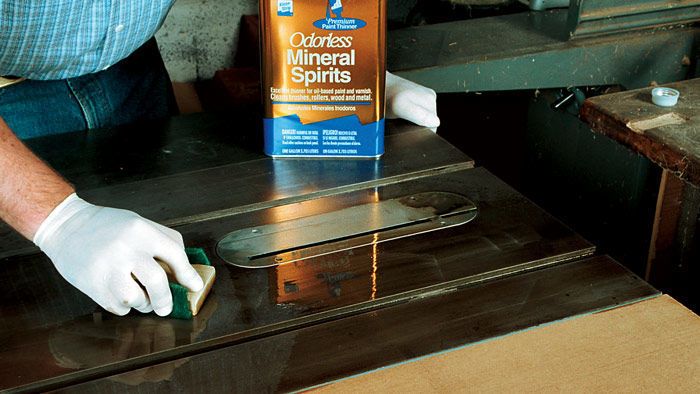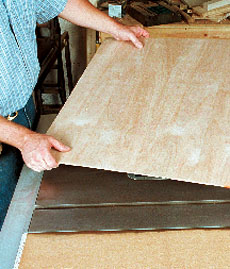Removing and Preventing Rust on Machinery
Scour a cast-iron surface, then protect it from dampness
First, remove the rust. Scour the surface with mineral spirits and synthetic steel wool or 400-grit wet-or-dry sandpaper. Wipe off the surface with a clean cloth, and repeat as necessary.
Even when rubbed with paraffin wax, the cast-iron top on a new tablesaw may tarnish and start to rust. Cast iron is notorious for tarnishing quickly anytime it gets the least bit damp. And paraffin wax is a relatively poor lubricant and water repellent compared with more modern materials. The good news is that it is easy to have your cast iron looking like new in just a few minutes, and even easier to keep it looking that way indefinitely.
The first order of business is to remove the tarnish, rust and wax. I would use a rubber sanding block and some 400-grit wet-or-dry sandpaper or fine-grit synthetic steel wool. Wear rubber gloves and use a small amount of mineral spirits to help cut through the wax. It should take only a few minutes of rubbing until the surface is smooth and shiny again. Wipe down the tabletop and miter slots with a clean rag and keep adding clean mineral spirits until all of the dirt, wax and rust have been removed.
I quit using paraffin wax on my tools the day I discovered TopCote, a dry, silicone-free surface lubricant and water repellent manufactured by Bostik. It doesn’t build up a sticky residue the way paraffin wax inevitably does, the lubrication lasts almost indefinitely, and most important, it really keeps moisture out. Spray a liberal coat on the surface, let it dry for a few seconds, and buff with a paper towel. I repeat this every few months. TopCote and other similar silicone-free products are available in popular woodworking catalogs. By the way, this method of removing rust and protecting the surface will work for all the metal tools in your shop.
![]() Next, apply a protectant. After allowing the residual mineral spirits to flash off, apply a silicone-free coating such as TopCote. This will protect the tabletop and make it a slicker surface for workpieces.
Next, apply a protectant. After allowing the residual mineral spirits to flash off, apply a silicone-free coating such as TopCote. This will protect the tabletop and make it a slicker surface for workpieces. 
Finally, make a plywood cover for the surface. Every night before leaving the shop, lower the blade and cover the saw with plywood to help keep the surface rust-free.
Finally, to keep your saw looking like new for the rest of its life, make a simple cover for it. Cut a sheet of 1/8-in. or 1/4-in. plywood to the size of your top. The last thing I do before I leave the shop in the evening is lower the tablesaw blade, move the rip fence out onto the extension table and place the protective plywood cover over the cast-iron table. One parting thought on the plywood cover: Mark it clearly so you don’t mistakenly cut it up into drawer bottoms. (Not that I’ve ever done that.)
Lon Schleining is a woodworker in Long Beach, California.
Adapted from Fine Woodworking #145, p. 108
More Tips on How to Deal with Rust:
- Salt and Vinegar: Nature’s Rust Remover
- Quick Tip: Use Pumice to Remove Rust
- The Best Rust Preventers
- Camellia Oil to the rescue
Fine Woodworking Recommended Products

Ridgid EB4424 Oscillating Spindle/Belt Sander


Starrett 12-in. combination square






















Comments
I use BOESHIELD T-9 on all my iron surfaces. It is a good rust and corrosion protection and also a lubricant.
Hello! Thank you for the helpful information. Do you think this same technique would work for removing rust and grime from an old cast iron letter press?
Log in or create an account to post a comment.
Sign up Log in